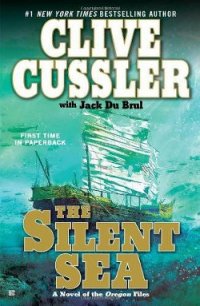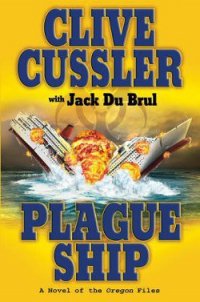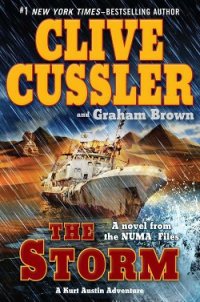Skeleton Coast - Cussler Clive (книги txt) 📗
Several decks below the ship’s bridge, where Cabrillo and Lincoln had stood when theOregon docked, was the operations center, the brain of the vessel. From there, her crew of retired U.S. military and CIA operatives ran the entire ship, from her engines and dynamic positioning system to all her weapons. They also possessed a suite of radar and sonar gear that was among the best a considerable amount of money could buy.
It was from the op center that theOregon ’s preeminent helmsman, Eric Stone, had actually docked the vessel, using athwartship bow and stern thrusters and input from the global positioning system, all linked to a supercomputer that gauged wind speed, currents, and a dozen other factors. It was this computer that employed the exact amount of reverse thrust required to keep theOregon in position against the flow of the Congo River.
Cabrillo and Max stepped into a utility closet that reeked of turpentine while Linc headed off to meet with Eddie Seng and the rest of the shore operations specialists in case they were needed to keep the rebels from gaining the deck. Juan spun the handles for the slop sink like the dials of a safe and the closet’s back wall opened to reveal a hallway beyond.
Unlike the cheap linoleum and peeling paint of the bridge and other sections of the superstructure, this secret interior passage was well lit, with rich mahogany paneling and plush carpets. An original Winslow painting of a whaling ship hung from a wall and a glass-encased sixteenth-century suit of armor complete with sword and mace stood at the end of the hallway.
They strode past countless cabin doors until reaching the operations center at the heart of the freighter. It was as high-tech as NASA’s mission control, with computer work stations and a wall dominated by an enormous flat panel display currently showing the chaotic scene along the pier. Mark Murphy and Eric Stone sat at the forward work stations directly below the wall monitor while Hali Kasim, the ship’s chief communications specialist, was to the right. Along the back wall stood a pair of damage controllers monitoring the ship’s integrated safety systems and a bank of computers where Max Hanley could watch over theOregon ’s revolutionary magnetohydrodynamic engines.
It was no mistake that the op center had the feel of the bridge of television’s starshipEnterprise , right down to the large seat set in the middle of the room. Juan sat in what the crew called “The Kirk Chair,”
looped a pin microphone over his ear, and adjusted his own small computer display.
“I’ve got a pair of inbounds,” Hali said, his dark features made a ghastly green by his radar scope. “They must have been flying nap of the earth, suggesting choppers. ETA four minutes.”
“There are no known reports that Makambo has helicopters,” Mark Murphy said, turning to the chairman. “But Hali just got a bulletin about a pair of choppers stolen from an oil exploration company.
Details are sketchy but it reads like the company’s pilots were hijacked.”
Juan nodded, not sure what to make of this development.
“I’ve got movement behind us,” Eric Stone called out. He’d switched his personal view screen to show the view from a stern-mounted camera.
A pair of patrol boats had rounded a bend in the river. Lights atop their pilothouses made it difficult to tell how they were armed, but Mark Murphy at the weapons station called up a database of Congolese military craft.
“They’re American-built Swift boats.”
“You’ve got to be kidding me,” Max said. He’d served aboard Swift boats for two tours in Vietnam.
Murph continued as if Hanley hadn’t spoken. “Displaces twelve tons, has a crew of twelve, and comes armed with six fifty-caliber machine guns. Top speed is twenty-five knots. Note here says that Congo’s riverine forces have also added mortars and they might be carrying shoulder-fired missiles.”
With the situation worsening by the second, Cabrillo made his decisions. “Hali, get me Benjamin Isaka.”
Isaka was their contact in the government. “Tell him that elements of his military might have found out about our mission and don’t realize we’re on their side. Or that two of his Swift boats have been taken by Makambo’s men. Eric, get us the hell out of here. Murph, keep an eye on, well, everything, but do not fire without my say-so. If we give away our capabilities, Abala’s going to know he’s being set up and will leave the guns where they are. Speaking of that. Hali?”
Hali Kasim pushed a shock of curly black hair off his forehead and typed some keystrokes into his computer. “RDF tags are activated and broadcasting five-by-five.”
“Excellent.” Cabrillo spun in his chair to look at Max Hanley. “How about it, old boy?”
“You know we’re only on battery backup,” Max Hanley told him. “I can’t give you more than twenty knots.”
TheOregon had the most sophisticated marine propulsion system ever built. Her magnetohydrodynamic engines used superconductive coils cooled by liquid helium to strip free electrons from seawater. The electricity was then used to power four massive pump jets through two vector nozzles at the ship’s stern.
The engines could move the eleven-thousand-ton ship at speeds approaching that of an offshore race boat, and since she used seawater for fuel she possessed an infinite range. Because of a fire two years earlier on a cruise ship powered by magnetohydrodynamics, most of the world’s maritime safety boards had banned their use until they could be further tested, which was why theOregon flew the flag of Iran on her jack staff, a nation with a decidedly cavalier attitude toward maritime law.
Tied to a dock eighty miles up the Congo River from the Atlantic Ocean, theOregon was surrounded by freshwater and thus couldn’t power up her engines. She had to rely on energy stored in ranks of silver-zinc deep cycle batteries to force water through her pump jets.
Having worked so closely with the navel architects and engineers when the ship was converted from a conventional lumber carrier, Cabrillo knew that even with the current running in their favor the batteries wouldn’t last more than sixty miles at full speed, twenty miles short of where the river discharged into the sea.
“Mr. Stone, what are the tidal conditions going to be in about three hours?” Cabrillo asked his helmsman.
“Mean high tide is in two hours thirty minutes,” Eric Stone replied without having to access the database.
As part of his job he kept track of tidal charts and weather forecasts five days out with the diligence of an accountant chasing a penny across a spreadsheet.
“This is going to be close,” Juan said to no one in particular. “Okay, Eric let’s get out of here before Abala’s men launch their assault.”
“Aye, Chairman.”
With a deft hand, Eric Stone ramped up the pulse jets. Without the whine of the cryopumps and ancillary equipment for the magnetohydrodynamic engines, the sound of water being forced through the tubes was a deep rumble that reverberated through the entire vessel. He dialed up the bow and stern thrusters and the massive ship moved laterally away from the dock at the same time she started straining against her mooring hawsers.
Sensing their quarry was about to escape, the rebels lining the quay opened fire with long sustained bursts from their automatic weapons. Bullets raked the ship from stem to stern. Windows lining the bridge exploded under the onslaught and portholes winked out in cascades of glass. Sparks flew from the Oregon ’s hull as hundreds of rounds were deflected by her armored belts. While it was a spectacular sight, the rebels did nothing but mar paint and destroy a few pieces of easily replaceable glass.
From astern, the approaching patrol boats added the pounding rhythm of their fifty calibers. In order to reach the rendezvous, theOregon rode high in the water, the special ballast tanks running along her flanks used to simulate her carrying a load of goods pumped dry. This afforded the gunners racing down the river a clear view of her rudder. They concentrated their fire on the rudder post, hoping to dislodge it from the steering gear and render the big ship helpless to the whims of the current. On a normal vessel their strategy was sound; theOregon ’s rudder could turn the ship when necessary, like in a port under the watchful eye of harbor officials, but she got most of her maneuverability from the vectored nuzzles of her drive tubes, which were well protected below the waterline.




